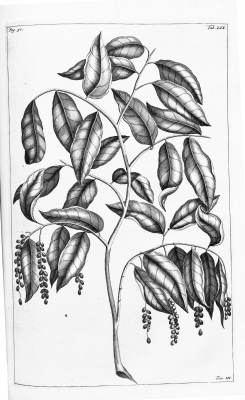Antidesma stipulare
Blume
Phyllanthaceae
Antidesma amboinense Miq.
Antidesma cordatostipulaceum Merr.
Antidesma diepenhorstii Miq.
Antidesma grandistipulum Merr.
Antidesma sarawakense Merr.
Antidesma stenophyllum Gage
Common Name:
General Information
Antidesma stipulare is a shrub or a tree that can grow up to 10 metres tall. The bole can be up to 15cm in diameter[
327- Title
- Euphorbiaceae of Malesia
- Publication
-
- Author
-
- Website
- http://www.nationaalherbarium.nl/euphorbs/
- Publisher
-
- Year
- 0
- ISBN
-
- Description
- An online resource that is still being developed, it gives detailed botanical descriptions of plants in the family Euphorbiaceae found growing in Malesia (the region from Peninsual Malaysia through Indonesia, the Philippines).
].
The tree is harvested from the wild for local use of its wood.
Known Hazards
None known
Botanical References
327- Title
- Euphorbiaceae of Malesia
- Publication
-
- Author
-
- Website
- http://www.nationaalherbarium.nl/euphorbs/
- Publisher
-
- Year
- 0
- ISBN
-
- Description
- An online resource that is still being developed, it gives detailed botanical descriptions of plants in the family Euphorbiaceae found growing in Malesia (the region from Peninsual Malaysia through Indonesia, the Philippines).
Range
Southeast Asia - Malaysia, Indonesia, Philippines.
Habitat
Understorey of both dense primary and more open secondary forests; from the lowlands to the mountains; on clay, loam, peat and sands, often acidic, sometimes ultrabasic soil; over limestone, basalt, sandstone and shale; at elevations to 1,800 metres[
327- Title
- Euphorbiaceae of Malesia
- Publication
-
- Author
-
- Website
- http://www.nationaalherbarium.nl/euphorbs/
- Publisher
-
- Year
- 0
- ISBN
-
- Description
- An online resource that is still being developed, it gives detailed botanical descriptions of plants in the family Euphorbiaceae found growing in Malesia (the region from Peninsual Malaysia through Indonesia, the Philippines).
].
Properties
| Other Uses Rating |      |
| Habit | Tree |
| Height | 7.50 m |
| Self-fertile | N/A |
| Cultivation Status | Wild |
Cultivation Details
Found in the wild on clay, loam, peat and sandy soils; often acidic, sometimes ultrabasic soil; over limestone, basalt, sandstone and shale[
327- Title
- Euphorbiaceae of Malesia
- Publication
-
- Author
-
- Website
- http://www.nationaalherbarium.nl/euphorbs/
- Publisher
-
- Year
- 0
- ISBN
-
- Description
- An online resource that is still being developed, it gives detailed botanical descriptions of plants in the family Euphorbiaceae found growing in Malesia (the region from Peninsual Malaysia through Indonesia, the Philippines).
].
A dioecious species, both male and female forms need to be grown if fruit and seed are required[
327- Title
- Euphorbiaceae of Malesia
- Publication
-
- Author
-
- Website
- http://www.nationaalherbarium.nl/euphorbs/
- Publisher
-
- Year
- 0
- ISBN
-
- Description
- An online resource that is still being developed, it gives detailed botanical descriptions of plants in the family Euphorbiaceae found growing in Malesia (the region from Peninsual Malaysia through Indonesia, the Philippines).
].
Edible Uses
None known
Medicinal
None known
Other Uses
The sapwood is white to yellowish[
327- Title
- Euphorbiaceae of Malesia
- Publication
-
- Author
-
- Website
- http://www.nationaalherbarium.nl/euphorbs/
- Publisher
-
- Year
- 0
- ISBN
-
- Description
- An online resource that is still being developed, it gives detailed botanical descriptions of plants in the family Euphorbiaceae found growing in Malesia (the region from Peninsual Malaysia through Indonesia, the Philippines).
]. The wood is strong and resistant to termites. It is used for household and construction purposes[
327- Title
- Euphorbiaceae of Malesia
- Publication
-
- Author
-
- Website
- http://www.nationaalherbarium.nl/euphorbs/
- Publisher
-
- Year
- 0
- ISBN
-
- Description
- An online resource that is still being developed, it gives detailed botanical descriptions of plants in the family Euphorbiaceae found growing in Malesia (the region from Peninsual Malaysia through Indonesia, the Philippines).
].
Propagation
Seed -
If you have any useful information about this plant, please leave a comment. Comments have to be approved before they are shown here.


 Useful Tropical Plants Database 2014 by
Ken Fern,
web interface by
Ajna Fern
with help from
Richard Morris.
Useful Tropical Plants Database 2014 by
Ken Fern,
web interface by
Ajna Fern
with help from
Richard Morris.